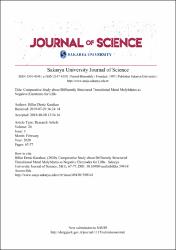| dc.contributor.author | Karahan, Billur Deniz | |
| dc.date.accessioned | 2022-02-28T08:01:00Z | |
| dc.date.available | 2022-02-28T08:01:00Z | |
| dc.date.issued | 2020 | en_US |
| dc.identifier.citation | Karahan, B. D. (2020). Comparative study about differently structured transitional metal molybdates as negative electrodes for LIBs. Sakarya University Journal of Science, 24(1), 67-77. https://doi.org/10.16984/saufenbilder.598141 | en_US |
| dc.identifier.issn | 1301-4048 | |
| dc.identifier.issn | 2147-835X | |
| dc.identifier.uri | https://doi.org/10.16984/saufenbilder.598141 | |
| dc.identifier.uri | https://hdl.handle.net/20.500.12511/9018 | |
| dc.description.abstract | The nanostructured materials represent the center of fundamental advances to design new era electrodes for high energy density batteries. Especially, one-dimensional nanomaterials are recognized as a solution due to their large surface area, short diffusion distance and high volume accommodation ability. In this sense, first in literature a comparative study has been done to examine the electrochemical performances of differently fabricated transition metal oxide molybdate powders: lithium storage capabilities of nickelcobalt-molybdate composite is compared to that of the cobalt oxide decorated nickel molybdate powders. To measure the effect of cobalt atom, bare nickel molybdate powders have been also fabricated and tested. The lithiation mechanism of these electrodes are discussed based on the cyclic voltammetry curvatures. SEI layer formation on the electrodes and the electrode/electrolyte stability upon cycling are analyzed following the electrochemical impedance spectroscopy test results (after 1st, 2nd and 4th cycles). The results reveal that the addition of cobalt changes the powder morphology and improves the electrochemical performance of the electrode. Among three samples, the cobalt oxide decorated nickel molybdate performs higher retention and rate performance since the top layer promotes more stable electrode/electrolyte interface providing a capacity of 290 mAh/g after 100 cycles. The rate performance of the sample is also found promising, the electrode delivers 200 mAh/g even under a current load of 400mA/g. | en_US |
| dc.language.iso | eng | en_US |
| dc.publisher | Sakarya University | en_US |
| dc.rights | info:eu-repo/semantics/openAccess | en_US |
| dc.subject | Metal Molybdates | en_US |
| dc.subject | Lithium Ion Batteries | en_US |
| dc.subject | Hydrothermal Method | en_US |
| dc.subject | Anode | en_US |
| dc.title | Comparative study about differently structured transitional metal molybdates as negative electrodes for LIBs | en_US |
| dc.type | article | en_US |
| dc.relation.ispartof | Sakarya University Journal of Science | en_US |
| dc.department | İstanbul Medipol Üniversitesi, Mühendislik ve Doğa Bilimleri Fakültesi, İnşaat Mühendisliği Bölümü | en_US |
| dc.authorid | 0000-0002-7839-2222 | en_US |
| dc.identifier.volume | 24 | en_US |
| dc.identifier.issue | 1 | en_US |
| dc.identifier.startpage | 67 | en_US |
| dc.identifier.endpage | 77 | en_US |
| dc.relation.publicationcategory | Makale - Ulusal Hakemli Dergi - Kurum Öğretim Elemanı | en_US |
| dc.identifier.doi | 10.16984/saufenbilder.598141 | en_US |
| dc.institutionauthor | Karahan, Billur Deniz | |
| dc.identifier.trdizinid | TkRjeU1qUTJOZz09 | en_US |


















